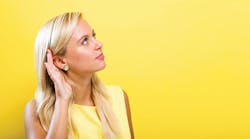Dental professionals and hearing loss: A growing concern
An increasing number of dental professionals now experience significant hearing loss. The issue of noise-induced hearing loss received little attention in the educational arena until recently, but the tide is turning with more academic institutions now addressing the need for hearing protection.
Risk for compromised hearing
Despite this increased awareness, many clinicians today are grappling with compromised hearing. Typically, occupational noise-induced hearing loss occurs when the human ear is subjected to loud noises over long periods of time. Although everyone’s occupational exposure is different, it is now understood that the cumulative effects of exposure to 85 dB over an eight-hour day will affect human hearing.1
It’s not just how often you use a power scaler. The problem is compounded by noise from the suction, the sound of the high-speed handpiece in the next cubicle, and the compressor or lab grinder down the hall. Lifestyle choices and genetics also play a role in accelerating hearing loss.
Since noise-induced hearing loss is cumulative over time, many dental professionals are not well prepared for a future that involves hearing loss. Along with having to cope with diminished hearing, the cost of assistive hearing devices, commonly known as hearing aids, causes sticker shock for many people.
Noise exposure over time
Kelly, a dental hygienist in Washington State, first noticed problems with her hearing in 2011, but she attributed it to high ear wax production and seasonal allergies. Throughout her 27-year career, she was an avid power-scaler user. Her daily exposure included the noise from her scaler and high-speed suction, coupled with the same noise from her dental hygiene colleague in the next room. She was also bombarded with noise bouncing off hard surfaces from dental drills, lab equipment, and the model trimmer. No one wore hearing protection in those days.
No one in Kelly’s family had a history of hearing loss, and her lifestyle did not include regular concert attendance or frequent exposure to loud lawn-care devices. Like a typical mom, she attended her children’s baseball games and had minimal exposure to loud kitchen appliances.
According to Kelly, “Unless you experience an explosion or physical injury, hearing loss is not black and white. You don’t wake up one day and say, ‘Bam! I know I have hearing loss.’” Kelly started noticing that voices sounded muffled when she used both her cell phone and landline. She also began mishearing some patient comments. This led her to get a baseline audiogram, and the results were shocking. Kelly had developed significant hearing loss in both ears, but her hearing loss was more profound in the ear that was closest to the power scaler and suction.
Importance of baseline data
Kelly strongly advises all dental professionals, including those who do not think they have hearing loss, to have a baseline audiogram performed by either an audiologist or an otolaryngologist (ENT). Just as with other health-care matters, documentation is key if—or when—a claim must be made.
Through the years, Kelly had treated veterans who had hearing issues. She learned there was no time limit for making a hearing loss claim from the labor board in her state. If approved, she would receive state-of-the-art, Bluetooth-equipped hearing aids with lifetime coverage for batteries and damage replacement. Armed with her test results, Kelly decided to make a claim with the Washington State Department of Labor and Industries (L&I), a group tasked with all aspects of workplace safety in her state.
Making a claim that will stick
As with any other worker compensation claim, there is a particular process that must be followed. In the state of Washington, the process begins with the audiologist. Once an audiogram is completed, the audiologist makes an appointment with the L&I doctor, who becomes the attending physician. The audiologist provides the correct L&I forms. According to Kelly, it is important to ask the audiologist’s office for support to ensure the forms are filled out correctly and completely.
Kelly’s L&I attending physician was a retired ENT specialist who worked directly with her audiologist’s office. To ensure that her claim was accurate, he asked Kelly a series of questions about regular exposure to loud noises outside of the dental office. Fortunately, Kelly could truthfully answer no. She did not have a history of exposure to other types of loud noise. There was also a question about tinnitus, which is ringing in the ear, which Kelly only noticed when lying quietly in bed right before sleeping. Finally, he asked if her hearing loss interfered with work, and she answered that, yes, she had difficulty hearing clearly when talking with patients.
Documentation of noise in the dental office is critical to supporting a claim. Kelly used two research studies and an article I wrote for RDH called Can you hear me now? Occupational noise-induced hearing loss among dental professionals to prove the noise dental professionals are exposed to every day. These papers detailed the decibel levels produced by equipment used routinely in the dental office. Kelly and her colleagues were exposed to multiple sources of loud noise every day. Her claim also pointed out that dental offices are not routinely built with noise-buffering doors, and her office was designed with two exit and entry areas that were completely open to all operatories.
Cumulative dental office noise
Dental offices are virtual noise tanks, a problem compounded by the fact that they are built with hard surfaces that are easy to clean and disinfect. Hard surfaces do not muffle or attenuate noise but instead intensify sounds. Unless someone understands how dentistry is actually performed, a claims manager might not realize that anytime a high-speed handpiece or an ultrasonic scaler is being used, a loud suction device is also being used. Additional noise that is simultaneous, not sequential, is additive. Suction noise is always present with the use of these mechanical devices. The combined effect of the two noise sources far surpasses allowable decibel levels.
Kelly’s attending physician made sure the forms were filled out correctly and filed the claim on her behalf. The claim was approved in two weeks, and she did not require any additional legal support during the process. Kelly now wears hearing aids in both ears. If her claim had not been granted, her out-of-pocket cost would have been $5,300. While Kelly’s story has a successful outcome, the risk of further damage to her hearing propelled her to leave her full-time dental hygiene career and transition into working as a realtor.
Kelly is passionate about sharing her story with other dental professionals. She has some advice to share:
• Begin wearing hearing protection immediately.
• Purchase the best protection you can afford.
• Get a baseline audiogram.
• Document the conditions in your work environment.
• Measure the workspace decibel levels.
• Keep detailed records of noise exposure.
• Eliminate or limit unnecessary noise exposure at home.
• Wear ear protection outside of the office.
• Be aware of hearing loss symptoms.
• Don’t be afraid to contact your state labor board.
• Learn about your options.
• File a detailed claim.
Hearing aids
Hearing aids are small, custom electronic devices that magnify sound vibrations. The vibrations are converted to signals to the brain. Hearing aids will not restore normal hearing but are designed to increase the wearer’s awareness of sounds and the source of sounds. There is an adjustment period when learning to use a hearing aid.3
An audiologist can help determine the most appropriate device for each individual and program the hearing aid to provide optimal benefits. Similar to other assistive devices, a wide range of hearing aid options are available:
Styles
• Behind the ear
• In the ear
• In the canal
Analog
• Custom-made for user
• Audiologist determines specifications
• Programmable—for quiet rooms, crowded spaces, or large open areas
• Used in all types of hearing aids
• Less expensive
Digital
• Programmable—can be adjusted for pitch or loudness
• Can amplify specific frequencies over others
• More customizable to the user’s needs or environments
• Used in all types of hearing aids
What can we learn? How to take action
The National Institute of Deafness and Other Communication Disorders (NIDCD), a division of the National Institutes of Health, is a great place to begin learning about hearing loss.2 Start your journey by answering the following 10 questions, which come from a questionnaire published by the NIDCD, to determine if you need to have your hearing tested.2 But remember, as a dental professional, you are already at risk for noise-induced hearing loss. If you answer yes to three or more of these questions, schedule a hearing evaluation with an otolaryngologist or audiologist:2
1. Do you sometimes feel embarrassed when you meet new people because you struggle to hear?
2. Do you feel frustrated when talking to members of your family because you have difficulty hearing them?
3. Do you have difficulty hearing or understanding coworkers, clients, or customers?
4. Do you feel restricted or limited by a hearing problem?
5. Do you have difficulty hearing when visiting friends, relatives, or neighbors?
6. Do you have trouble hearing in the movies or in the theater?
7. Do you have a hearing problem that causes you to argue with family members?
8. Do you have trouble hearing the TV or radio at levels that are loud enough for others?
9. Do you feel that any difficulty with your hearing limits your personal life or social life?
10. Do you have trouble hearing family or friends when you are together in a restaurant?2
Even if you don’t live in the state of Washington, L&I has a website that is easy to navigate and contains a plethora of information about workers’ injuries and claim processes. While your state might not have the same worker support, you can still use the website to learn about workers’ compensation.
Three different documents provide a wealth of information on how one state supports workers. The first is a detailed guide called “Workers’ compensation benefits: A guide for injured workers.”ii This detailed document reviews how worker injuries are dealt with in this state. While lengthy, it provides a solid foundation on the entire process. Two other documents shed additional light on the process. The second is the actual questionnaire that is filled out on behalf of workers who claim work-related noise-induced hearing loss.iii When considering filing a claim, it is advisable to review potential questions and be prepared to document your situation. The third document is a very black-and-white agreement that spells out the responsibilities of both L&I and the claimant when an agreement is made.iv
Originally posted in 2018 and updated regularly
Learn more
i. Guignon AN. Can you hear me now? Hear about occupational noise-induced hearing loss among dental professionals. RDH magazine website. http://www.rdhmag.com/articles/print/volume-36/issue-6/contents/can-you-me-now.html. Published June 17, 2016. Accessed July 15, 2018.
ii. Worker’s compensation benefits: A guide for injured workers. Washington State Department of Labor & Industries website. https://www.lni.wa.gov/IPUB/242-104-000.pdf. Published September 2017. Accessed July 15, 2018.
iii. Occupational hearing loss questionnaire. Washington State Department of Labor & Industries website. https://www.lni.wa.gov/Forms/pdf/F262-016-000.pdf. Published June 2015. Accessed July 15, 2018.
iv. Hearing services worker information. Washington State Department of Labor & Industries website. https://www.lni.wa.gov/forms/pdf/F245-049-000.pdf. Published April 2014. Accessed July 15, 2018.
References
1. Noise-induced hearing loss. National Institute on Deafness and Other Communication Disorders website. https://www.nidcd.nih.gov/health/noise-induced-hearing-loss. Updated February 7, 2017. Accessed July 15, 2018.
2. Do you need a hearing test? National Institute on Deafness and Other Communication Disorders website. https://www.nidcd.nih.gov/health/do-you-need-hearing-test. Updated May 17, 2016. Accessed July 15, 2018.
3. Hearing aids. National Institute on Deafness and Other Communication Disorders website. https://www.nidcd.nih.gov/health/hearing-aids. Updated March 6, 2017. Accessed July 15, 2018.







